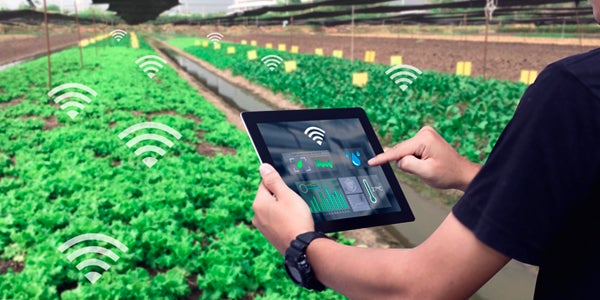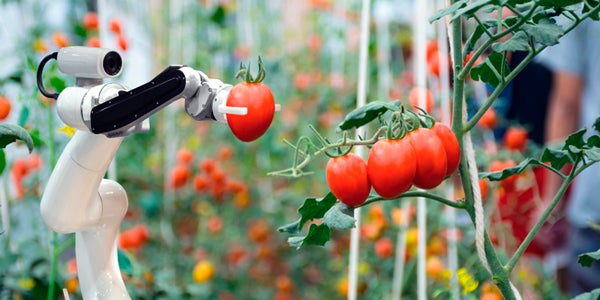American farmers contribute significantly to the overall US GDP annually and figures in this regard highlight just how significant their services are.
The last two years, in particular, have seen significant growth as farmers have looked to expand. With this level of growth, however, comes more overheads—particularly in the form of software and tech requirements. Read more here on what you should consider in your growth phase.
Americans love to spend on food. According to data from the US Department of Agriculture, agriculture, food, and related industries accounted for $1.055 trillion (or 5%) of overall US GDP in 2020. Of that sum, American farmers contributed $134.7 billion, exemplifying the critical role they play in the American food supply chain. However, as farmers tackle ongoing challenges brought on by supply chain issues and labor shortages, they must examine their current farming technology and ask themselves an important question: Is it time to upgrade?
Some farmers may have expanded to grow more crops on more land over the past two or three years. While their legacy farming technology systems worked as a mid-sized farm, scaling up requires more robust software and tech. Meanwhile—supply chain and labor issues aside—farmers are also susceptible to several risks that other business leaders may not have to consider, such as natural disasters, climate change, and environmental degradation.
AgriBusiness leaders can lean on the latest farming technology to safeguard themselves against such risks. Advancements in automation, Internet of Things (IoT), Augmented Reality (AR), and Artificial Intelligence (AI) only scratch the service. What indicators should you be looking for to know when it's time to upgrade your current farming technology?
Challenges in Managing a Growing Farming Business

The UN predicts that the global population will swell by two billion people—bringing the total to over 9 billion—by 2050. In turn, farmers must produce almost double the amount of food over the next three decades to accommodate that population boom.
While that seems a ways away, mid-sized American AgriBusiness leaders looking to capitalize should start planning today for success ten, even twenty years down the road. Farmers must be open to ingenuity and flexibility to overcome the common challenges they face today—and to prepare for a future where food is in incredibly high demand. They’re being forced to adapt as each new reality surfaces.
American AgriBusiness leaders face the same stress tests. The most concerning problems revolve around climate change, and how a changing ecosystem affects tangibles like groundwater levels, soil, and available resources.
Meanwhile, as the climate changes, so do consumers' tastes and expectations. Diet trends come and go, and as health and wellbeing rise top-of-mind in the wake of Covid-19, American farmers must adapt to these trends or risk falling behind. Today's consumers expect a high-quality product with little room for error. Bringing something to market that doesn't meet current demand standards could harm your brand and reputation.
Some of the most prominent challenges for American AgriBusiness leaders revolve around adopting new farming technology as it comes to market. Most mid-to-large-sized farms already have a farming technology software system in place. These systems connect accounting, staff management, asset tracking, and weather monitoring systems, but legacy solutions may be disconnected from modern advancements.
Thankfully, the current market is ripe with advanced, integrated farm management systems designed specifically for large-scale operations. Upgrading your current farming technology allows for:
- Better Land Management: Advanced management systems provide a better understanding of your most important asset—your land. Now you can make more actionable plans, backed by real-time data, regarding which crops to grow where.
- Robust Risk Management: Many farms are at the mercy of Mother Nature. Smart farming technology can strengthen your risk assessment practices by tracking weather conditions and making accurate predictions.
- Optimal Cost Management: Farming technology ensures you're only using the resources necessary for the required yield. This lets you cut back on waste while maximizing available resources. Farm management software can also alleviate labor costs by predicting when the need for labor will be high, and when you can free unnecessary hours.
Factors to Consider When Choosing Commercial Farm Management System

Now that we've established the benefits of upgrading your farm management system (FMS), AgriBusiness owners still need to know what they should look for when exploring the market for an upgrade.
Business-minded growers want to get the most out of their financial data and understand what makes their business profitable. Advanced FMS quickly uncovers best practices you may have overlooked in the past while doubling as a strategic, efficiency-driving tool.
However, narrowing down the best FMS for your operation can seem daunting given all the available farming technology. Still, it's a challenge worth tackling if you want to see your farm grow to meet your strategic goals. First, it helps if you ask yourself a few critical questions:
Will This Farming Technology Help Me Achieve My Goals?
Not all software will align with your current goals. Some may provide systems you don't need, while others fall short of essential practices important to you. Still, most FMSs come with several key features. These should include:
- Budgeting, record-keeping, and planning
- Cost analysis and comparisons
- Task management
- Inventory management
When deciding on a new FMS, consider which areas of your farming practice could use improvement. Do you find you're spending over your project budget? Could this extra spending be due to a lack of effective inventory management?
How Will My Data Integrate With This System?
Data is the heart of the modern business world—AgriBusiness included. When researching for new FMS software, dig into how the data-integration process works. Will this software easily integrate with your current workflows? If not, will it improve how you visualize data while reflecting the reality of what's happening on your farm?
Any reputable FMS software will support a mobile application, allowing you to keep track of your data from the comfort of your smartphone, leveraging cloud technology to ensure you can access your data whenever and wherever you need it.
Finally, the best FMS software doesn't require manual data entry. The systems can integrate with your current equipment, so data flows from the field to the FMS in real-time.
While collecting lots of data sounds good on paper, whether or not that data provides actionable insight is far more important. A strong FMS goes beyond data collection, using AI technology to generate valuable insights that drive agile decision-making.
Will This Farming Technology Scale With My Business?
To meet growing population demands, farming operations today must grow and expand. As such, their farming technology systems will need to grow alongside them. Investing in an FMS that's built future-ready, has regular updates and tech support, and offers robust cybersecurity for your data is crucial for future success.

As your farm grows, determine if your FMS can handle a more complex growing operation. Don't be afraid to get specific and share your growth goals with FMS vendors to determine if their products will meet your needs. Will the licensing get more expensive as you add more land and users? In our tight economic times, the licensing and fee structure is a factor you can't risk overlooking.
Each day on the farm brings new responsibilities and unplanned risks. As such, your FMS must be able to adapt on the fly, allowing for quick, real-time decision-making to stay on track. Some AgriBusiness leaders may only see dollar signs when thinking about a new FMS. The truth is, an advanced FMS that integrates into your current systems can save you money in the long run. However, those savings hinge on the word 'integration.'
How Will the System Work With My Current Practices?
Investing in a new FMS that renders your existing systems obsolete will only cost more money in the end. Instead, invest in systems that work with your current practices. They should be intuitive while comprehensive, providing you with a support team that works when you need them.
One great resource to consult when researching how a potential system’s ability to integrate is its user training resources. Should you have questions about the more intricate functionalities of an FMS, consider spending some time reviewing their support materials. Such a crucial investment is certainly worth watching videos and reaching out to company representatives for demos.
Let's dive into some more specific features to look for when investing in upgrading your farming technology:
- Production Tracking: Tracks livestock, crops, and production while calculating related expenditures.
- Stock Valuation: Uses the most up-to-date market and taxation figures to calculate valuation.
- Real-Time Financial Reporting: Provides you with all the reports you need, with a few simple clicks.
- Multi-Farm Management: Keeps track of all your budgets in one cohesive system.
- GPS Tracking and Mapping: Uses GPS technology to provide accurate yield forecasting, while simultaneously leveraging RFID and EID ear tag sensors to track livestock.
- Climate Forecasting Driven by AI: Relies on sensor-based software to gather weather and climate data, allowing for more accurate decisions.
- Optimize Water Usage: Utilizes automated irrigation management to reduce water waste.
- Feed Automation: Ensures your livestock's nutritional intake to maintain healthy herds.
Another factor to consider when researching new farming technology is how this FMS will bolster your current inventory management practices. After all, effective inventory management is mission-critical to most businesses, and farming is no exception. A strong FMS keeps track of every asset on your farm while providing detailed reports on inventory levels.
Most importantly, these reports are accurate and free of human error. Accurate reports allow for better decision-making regarding new orders and shipments. Farmers can easily use their phones or tablets to check inventory levels and order on the fly, removing any unnecessary lag time.
Farmers should also be able to also keep tabs on their vendors with FMS software. Everyone makes mistakes—an advanced FMS helps you catch them before they turn into real problems. For example, one of your vendors may accidentally deliver the wrong amount of supplies, either too much or too little. Thanks to your FMS, you can determine if you've been overcharged for supplies you didn't order or never received.
Smart Farming: The Future of Commercial Agriculture

Information and communication technology (ICT) trends brought "smart farming" into the mainstream. These trends are expected to ring in a new age of farming, often referred to as the "Third Green Revolution."
This Third Green Revolution leverages ICT solutions like the Internet of Things (IoT), precision equipment, sensors and actuators, geo-positioning systems, unmanned aerial vehicles (UAV/drones), robotics, Big Data, and more to keep farming up to date with the rest of the business world. Investing in smart farming technology is among the best future-ready decisions modern farms can make, given the advantages it can bring to a business.
For starters, smart farming technology reduces manual labor significantly, thus eliminating the chance of human error. For example, a human taking a pig's temperature might return an inaccurate reading, whether they misread the thermometer or didn't insert it correctly. On the other hand, a temperature bolus inside the pig's rumen transmits accurate data directly to your FMS.
Smart farming technology also allows for comprehensive data collection, which you can leverage to track business affairs and security. Data also provides insight into staff performance, equipment health, and overall efficiency.
When it comes time to grow, smart farming technology gives you more control over your internal practices. More control leads to better plans; better plans reduce waste and achieve a higher ROI. Farmers can predict how large their yield will be and line up buyers accordingly, even from remote settings.
Smart farming trends go hand-in-hand with precision farming. Where smart farming aims to boost efficiency, precision farming's goal is to boost accuracy. Both practices can lead to higher yields, reduced waste, and optimized labor expenses.
The Time to Start Preparing Is Now
Given the UN's population predictions between now and 2050, it’s never been more critical for American farmers to ensure they are optimizing their farming technology practices. Leveraging IoT tech, AI, drones, and sensors—among other tools—is crucial to meeting the rising demand for high-quality products.
While the benefits are clear, there's no denying the financial investment required to implement these changes. Thankfully, American farmers can always rely on a trusted financial partner with deep food and AgriBusiness expertise like Dubuque Bank & Trust, a division of HTLF Bank to guide them through the process.
AgriBusiness leaders overcame many challenges in the last few years alone. Between a global pandemic, ongoing supply chain issues, widespread labor shortages, and geopolitical conflict, American farmers must be ready to invest in upgrading to new technology to stay ahead of developing and future challenges as well.
Contact Dubuque Bank & Trust, a division of HTLF Bank today to speak with a commercial banker with AgriBusiness insight to learn more about emerging farming technology trends and how they can drive profits and efficiency on an expanding and growing farming operation.









